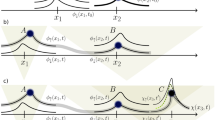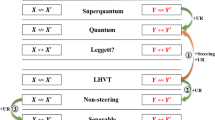Abstract
Bell’s theorem is purported to demonstrate the impossibility of a local “hidden variable” theory underpinning quantum mechanics. It relies on the well-known assumption of ‘locality’, and also on a little-examined assumption called ‘statistical independence’ (SI). Violations of this assumption have variously been thought to suggest “backward causation”, a “conspiracy” on the part of nature, or the denial of “free will”. It will be shown here that these are spurious worries, and that denial of SI simply implies nonlocal correlation between spacelike degrees of freedom. Lorentz-invariant theories in which SI does not hold are easily constructed: two are exhibited here. It is conjectured, on this basis, that quantum-mechanical phenomena may be modeled by a local theory after all.
Similar content being viewed by others
References
Bell, J.: On the Einstein–Podolsky–Rosen paradox. Physics 1, 195–200 (1964)
Bell, J.: La nouvelle cuisine. In: Bell, M., Gottfried, K., Veltman, M. (eds.) John S. Bell on the Foundations of Quantum Mechanics, pp. 216–234. World Scientific, Singapore (2001)
Bohm, D.: Quantum Theory. Prentice-Hall, Englewood Cliffs (1951)
Bohm, D.: A suggested interpretation of the quantum theory in terms of hidden variables. 1. Phys. Rev. 85, 166–179 (1952)
Bohm, D.: A suggested interpretation of the quantum theory in terms of hidden variables. 2. Phys. Rev. 85, 180–193 (1952)
Clauser, J.F., Horne, M.A., Shimony, A., Holt, R.A.: Proposed experiment to test local hidden variable theories. Phys. Rev. Lett. 23, 880–884 (1969)
Conway, J., Kochen, S.: The free will theorem. Found. Phys. 36, 1441 (2006)
Costa De Beauregard, O.: S Matrix, Feynman zigzag and Einstein correlation. Phys. Lett. A 67, 171–174 (1978)
Courant, R.: Methods of Mathematical Physics, Vol. II: Partial Differential Equations. Interscience, New York (1962)
Craig, W., Weinstein, S.: On determinism and well-posedness in multiple time dimensions. Proc. R. Soc. A (2008, forthcoming). arXiv:0812.0210
Einstein, A., Podolsky, B., Rosen, N.: Can quantum-mechanical description of reality be considered complete? Phys. Rev. 47, 777–780 (1935)
Fahmi, A.: Non-locality and classical communication of the hidden variable theories (2005). arXiv:quant-ph/0511009
Fine, A.: Correlations and physical locality. In: Asquith, P., Giere, R. (eds.) PSA 1980, vol. 2, pp. 535–556. Philosophy of Science Association, E. Lansing (1981)
Fine, A.: The Shaky Game: Einstein, Realism and the Quantum Theory. University of Chicago Press, Chicago (1986)
Hume, D.: A Treatise of Human Nature. Oxford Univ. Press, Oxford (2000). Orig. pub. 1739–1740
Jarrett, J.: On the physical significance of the locality conditions in the Bell arguments. Noûs 18, 569–589 (1984)
Jarrett, J.: Bell’s theorem: a guide to the implications. In: Cushing, J., McMullin, E. (eds.) Philosophical Consequences of Quantum Theory, pp. 60–79. Univ. of Notre Dame Press, Notre Dame (1989)
John, F.: Partial Differential Equations, 4th edn. Springer, Berlin (1992)
Lewis, P.: Conspiracy theories of quantum mechanics. Br. J. Philos. Sci. 57, 359–381 (2006)
Price, H.: Time’s Arrow and Archimedes’ Point: New Directions for the Physics of Time. Oxford Univ. Press, Oxford (1996)
Redhead, M.: Incompleteness, Nonlocality, and Realism. Clarendon, Oxford (1989)
Seevinck, M.: Parts and wholes: an inquiry into quantum and classical correlations. Ph.D. thesis, Utrecht University (2008). arXiv:0811.1027
Shimony, A.: Controllable and uncontrollable non-locality. In: Kamefuchi, S., Ezawa, H., Namiki, M. (eds.) Foundations of Quantum Mechanics in Light of New Technology. The Physical Society of Japan, Tokyo (1984). Reprinted in A. Shimony, Search for a Naturalistic World View, vol. II, pp. 130–139, Cambridge Univ. Press, Cambridge (1993)
Shimony, A.: An exchange on local beables. In: Search for a Naturalistic World View, vol. II, pp. 163–170. Cambridge University Press, Cambridge (1993)
Spekkens, R.W.: Contextuality for preparations, transformations and unsharp measurements. Phys. Rev. A 71, 052108 (2005)
Sutherland, R.I.: Bell’s theorem and backwards in time causality. Int. J. Theor. Phys. 22, 377–384 (1983)
’t Hooft, G.: On the free will postulate in quantum mechanics (2007). arXiv:quant-ph/0701097
Weinstein, S.: Multiple time dimensions (2008). arXiv:0812.3869
Author information
Authors and Affiliations
Corresponding author
Additional information
This paper is dedicated to the memory of John A. Wheeler.
Rights and permissions
About this article
Cite this article
Weinstein, S. Nonlocality Without Nonlocality. Found Phys 39, 921–936 (2009). https://doi.org/10.1007/s10701-009-9305-x
Received:
Accepted:
Published:
Issue Date:
DOI: https://doi.org/10.1007/s10701-009-9305-x




